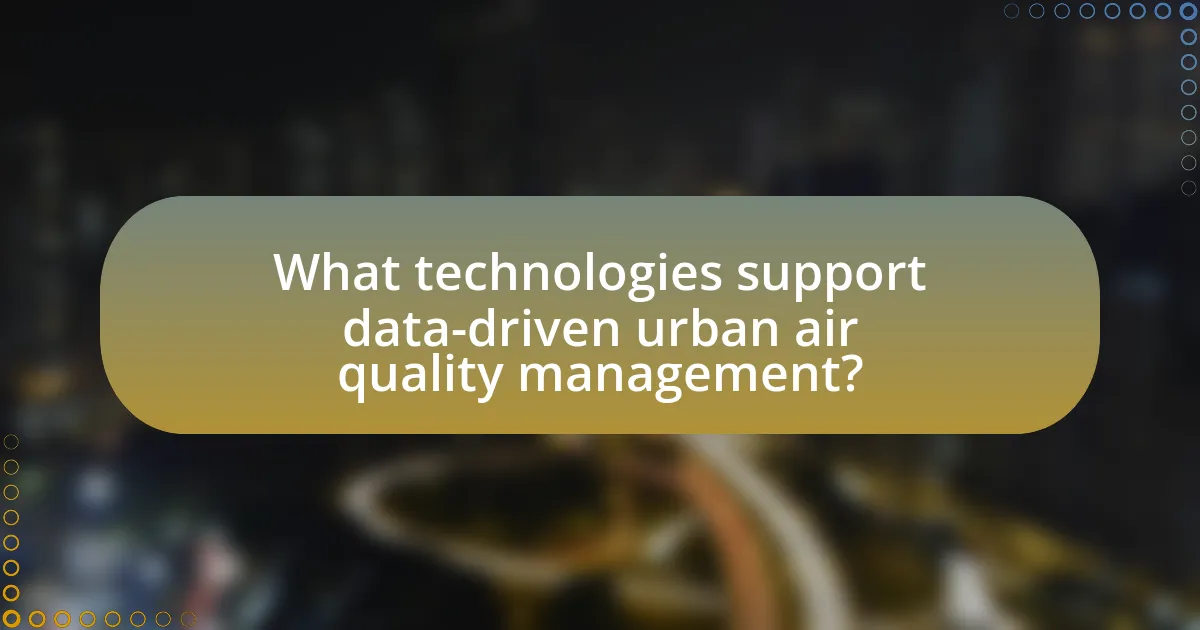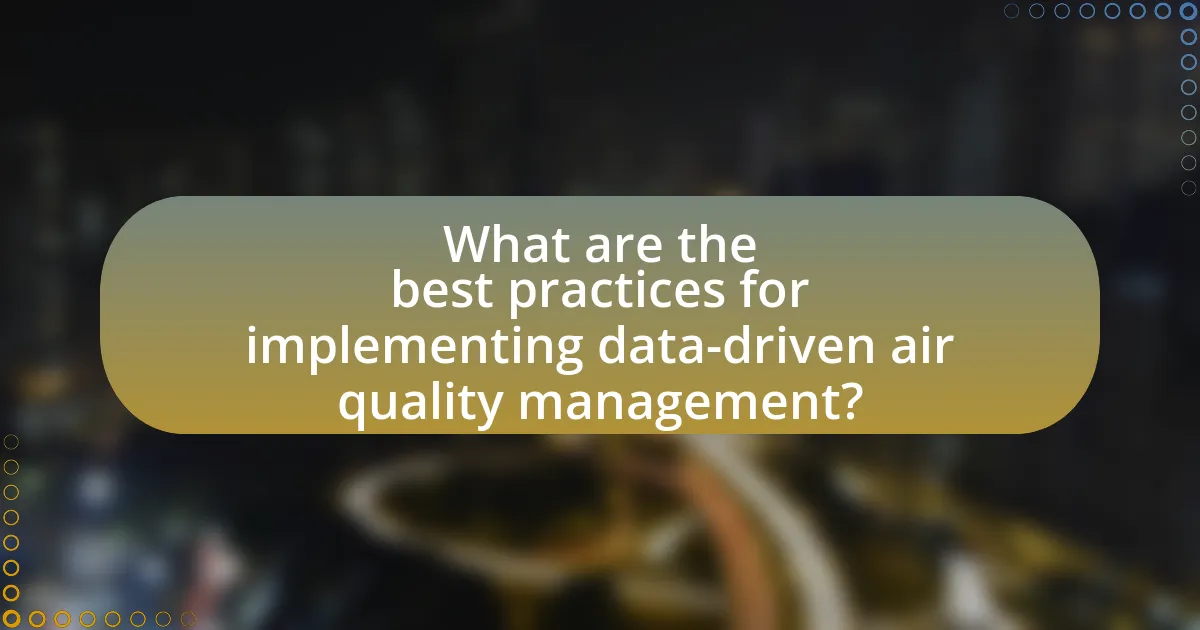Data-driven approaches to urban air quality management leverage real-time data collection and analysis to monitor and improve air quality in cities. Utilizing technologies such as sensors, satellite imagery, and data analytics, these methods help identify pollution sources, assess air quality levels, and predict future trends. The article discusses the types of data used, the importance of urban air quality management for public health and the environment, and the challenges cities face in implementing these strategies. It also highlights successful case studies and best practices for integrating data-driven methods into urban air quality initiatives, emphasizing the role of collaboration and community engagement in achieving effective outcomes.

What are Data-Driven Approaches to Urban Air Quality Management?
Data-driven approaches to urban air quality management utilize real-time data collection and analysis to monitor and improve air quality in urban environments. These approaches often involve the use of sensors, satellite imagery, and data analytics to identify pollution sources, assess air quality levels, and predict future air quality trends. For instance, cities like Los Angeles employ a network of air quality sensors that provide continuous data, enabling officials to implement targeted interventions based on specific pollution events. Studies have shown that cities using data-driven strategies can reduce air pollution levels by up to 30% through informed policy decisions and public awareness campaigns.
How do data-driven approaches enhance urban air quality management?
Data-driven approaches enhance urban air quality management by utilizing real-time data collection and analysis to inform decision-making and policy development. These approaches leverage technologies such as sensors, satellite imagery, and machine learning algorithms to monitor air pollution levels, identify sources of emissions, and predict air quality trends. For instance, cities like Los Angeles have implemented data-driven systems that integrate traffic data and meteorological information to optimize traffic flow and reduce vehicle emissions, leading to a measurable decrease in air pollutants. Additionally, studies have shown that cities employing data analytics can improve public health outcomes by effectively targeting interventions in areas with the highest pollution levels, thereby enhancing overall urban air quality management.
What types of data are utilized in these approaches?
Data-driven approaches to urban air quality management utilize various types of data, including real-time air quality measurements, meteorological data, traffic data, and land use information. Real-time air quality measurements are collected from monitoring stations and sensors that provide information on pollutants such as PM2.5, PM10, NO2, and O3. Meteorological data, including temperature, humidity, and wind speed, helps in understanding the dispersion of pollutants. Traffic data, which includes vehicle counts and types, is crucial for assessing emissions from transportation sources. Additionally, land use information aids in identifying pollution sources and understanding the spatial distribution of air quality. These data types collectively enhance the accuracy and effectiveness of urban air quality management strategies.
How is data collected and analyzed for air quality management?
Data for air quality management is collected through a combination of ground-based monitoring stations, satellite observations, and mobile sensors. Ground-based monitoring stations measure pollutants like particulate matter and gases, providing real-time data essential for assessing air quality. Satellite observations offer a broader view of air quality trends over large areas, while mobile sensors can capture localized data in specific urban environments.
The analysis of this data involves statistical methods and machine learning algorithms to identify patterns, predict pollution levels, and assess the effectiveness of air quality regulations. For instance, studies have shown that integrating data from various sources enhances the accuracy of air quality models, allowing for more effective management strategies.
Why is urban air quality management important?
Urban air quality management is important because it directly impacts public health, environmental sustainability, and economic stability. Poor air quality is linked to respiratory diseases, cardiovascular issues, and premature deaths; for instance, the World Health Organization estimates that air pollution causes approximately 7 million deaths annually worldwide. Effective management strategies can reduce pollutant levels, improve health outcomes, and enhance the quality of life for urban residents. Furthermore, data-driven approaches enable cities to monitor air quality in real-time, identify pollution sources, and implement targeted interventions, thereby fostering healthier urban environments.
What are the health impacts of poor air quality in urban areas?
Poor air quality in urban areas significantly impacts public health, leading to respiratory diseases, cardiovascular issues, and increased mortality rates. Studies indicate that exposure to pollutants such as particulate matter (PM2.5) and nitrogen dioxide (NO2) is linked to a higher incidence of asthma, chronic obstructive pulmonary disease (COPD), and heart attacks. For instance, research published in the journal “Environmental Health Perspectives” found that long-term exposure to PM2.5 can reduce life expectancy by approximately 1.5 years in urban populations. Additionally, the World Health Organization attributes around 4.2 million premature deaths annually to outdoor air pollution, underscoring the critical health risks associated with poor air quality in cities.
How does urban air quality affect the environment and economy?
Urban air quality significantly impacts both the environment and the economy. Poor air quality leads to environmental degradation, including increased greenhouse gas emissions and harm to ecosystems, which can result in biodiversity loss. Economically, cities with high levels of air pollution face increased healthcare costs due to respiratory and cardiovascular diseases, which can burden public health systems and reduce workforce productivity. For instance, the World Health Organization estimates that air pollution causes approximately 7 million premature deaths annually, leading to substantial economic losses, estimated at over $5 trillion globally in welfare costs.
What challenges do cities face in implementing data-driven approaches?
Cities face several challenges in implementing data-driven approaches, primarily including data integration, privacy concerns, and resource limitations. Data integration issues arise when cities struggle to consolidate information from various sources, leading to fragmented insights that hinder effective decision-making. Privacy concerns are significant as the collection and analysis of personal data can lead to potential misuse, creating resistance among citizens and stakeholders. Additionally, resource limitations, including financial constraints and lack of technical expertise, impede the development and maintenance of data-driven systems. According to a report by the Urban Institute, 70% of city officials cite insufficient funding as a barrier to adopting advanced data analytics for urban management.
What are the technological barriers to effective data collection?
Technological barriers to effective data collection include inadequate sensor accuracy, limited data transmission capabilities, and insufficient data integration systems. In urban air quality management, sensors may not provide reliable measurements due to calibration issues or environmental interference, leading to inaccurate data. Additionally, data transmission can be hindered by network limitations, particularly in densely populated areas where connectivity may be poor. Furthermore, the lack of robust data integration systems complicates the aggregation and analysis of data from various sources, making it difficult to derive actionable insights. These barriers collectively impede the effectiveness of data collection efforts in managing urban air quality.
How do policy and regulatory frameworks impact data-driven strategies?
Policy and regulatory frameworks significantly shape data-driven strategies by establishing the legal and operational boundaries within which organizations operate. These frameworks dictate data collection methods, usage, and sharing protocols, ensuring compliance with privacy and environmental standards. For instance, regulations like the General Data Protection Regulation (GDPR) in Europe impose strict guidelines on data handling, which can limit the types of data that can be utilized in urban air quality management strategies. Additionally, policies that promote transparency and public access to data can enhance collaboration among stakeholders, leading to more effective data-driven approaches. The impact of these frameworks is evident in how cities implement air quality monitoring systems, as they must align their strategies with existing laws to avoid penalties and foster public trust.

What technologies support data-driven urban air quality management?
Technologies that support data-driven urban air quality management include sensor networks, data analytics platforms, and geographic information systems (GIS). Sensor networks, such as low-cost air quality sensors, provide real-time data on pollutants, enabling cities to monitor air quality dynamically. Data analytics platforms process and analyze this data to identify trends and sources of pollution, facilitating informed decision-making. Geographic information systems (GIS) visualize air quality data spatially, allowing urban planners to assess the impact of various factors on air quality and implement targeted interventions. These technologies collectively enhance the ability to manage urban air quality effectively.
How do sensors and IoT devices contribute to air quality monitoring?
Sensors and IoT devices significantly enhance air quality monitoring by providing real-time data on pollutants and environmental conditions. These devices, equipped with various sensors, measure parameters such as particulate matter, nitrogen dioxide, and ozone levels, enabling continuous tracking of air quality. For instance, a study published in the journal “Environmental Science & Technology” by authors including Zhang et al. (2020) demonstrated that IoT-enabled sensors can detect air quality changes within minutes, allowing for timely public health responses. This data is transmitted to centralized systems for analysis, facilitating informed decision-making and effective urban air quality management strategies.
What types of sensors are most effective for urban air quality measurement?
Electrochemical sensors are the most effective for urban air quality measurement. These sensors provide real-time data on pollutants such as nitrogen dioxide, ozone, and particulate matter, which are critical for assessing air quality in urban environments. Studies have shown that electrochemical sensors can achieve high sensitivity and specificity, making them suitable for detecting low concentrations of harmful gases. For instance, research published in the journal “Environmental Science & Technology” demonstrates that these sensors can accurately monitor air quality in densely populated areas, providing valuable data for public health and urban planning initiatives.
How do IoT devices facilitate real-time data collection and analysis?
IoT devices facilitate real-time data collection and analysis by continuously monitoring environmental parameters and transmitting data instantaneously to centralized systems. These devices, equipped with sensors, collect data on air quality metrics such as particulate matter, carbon dioxide levels, and temperature. For instance, a network of IoT air quality sensors can provide minute-by-minute updates on pollution levels, enabling immediate responses to changing conditions. This capability is supported by technologies like cloud computing and edge computing, which allow for rapid data processing and analysis. The integration of IoT in urban air quality management has been shown to improve decision-making processes, as evidenced by studies indicating that cities utilizing IoT data have seen a 20% improvement in air quality management efficiency.
What role does big data play in urban air quality management?
Big data plays a crucial role in urban air quality management by enabling real-time monitoring and analysis of air pollution levels. This data-driven approach allows city planners and environmental agencies to identify pollution sources, assess health impacts, and implement targeted interventions. For instance, the integration of data from various sources, such as satellite imagery, ground sensors, and social media, provides a comprehensive view of air quality dynamics. Studies have shown that cities utilizing big data analytics can reduce air pollution levels by up to 30% through informed policy-making and public awareness campaigns.
How is big data analyzed to inform air quality policies?
Big data is analyzed to inform air quality policies through the integration of various data sources, including satellite imagery, ground-based sensors, and social media feeds, which provide real-time insights into pollution levels and sources. This analysis employs advanced statistical methods and machine learning algorithms to identify patterns and trends in air quality data, enabling policymakers to make informed decisions. For instance, a study by the Environmental Protection Agency demonstrated that using big data analytics improved the accuracy of air quality forecasting by 30%, allowing for timely interventions and more effective regulatory measures.
What are the benefits of using predictive analytics in air quality management?
Predictive analytics in air quality management enhances decision-making by providing accurate forecasts of air pollution levels. This enables authorities to implement timely interventions, such as issuing health advisories or adjusting traffic patterns to reduce emissions. For instance, a study by the Environmental Protection Agency found that predictive models can improve air quality forecasts by up to 30%, allowing for more effective public health responses. Additionally, predictive analytics helps identify pollution sources and trends, facilitating targeted regulatory measures and resource allocation.
How can machine learning improve air quality forecasting?
Machine learning can improve air quality forecasting by analyzing vast datasets to identify patterns and predict pollution levels more accurately. Traditional forecasting methods often rely on linear models and limited data, whereas machine learning algorithms can process complex, non-linear relationships in large datasets, including meteorological data, traffic patterns, and historical air quality measurements. For instance, a study published in the journal “Environmental Science & Technology” demonstrated that machine learning models outperformed traditional methods by achieving up to 20% higher accuracy in predicting PM2.5 levels in urban areas. This enhanced predictive capability allows for timely interventions and better public health responses to air quality issues.
What algorithms are commonly used for air quality prediction?
Common algorithms used for air quality prediction include linear regression, decision trees, random forests, support vector machines, and neural networks. These algorithms are employed due to their ability to model complex relationships between various environmental factors and air quality indicators. For instance, studies have shown that random forests can effectively handle non-linear data and interactions among variables, making them suitable for predicting pollutants like PM2.5 and NO2. Additionally, neural networks have been utilized for their capacity to learn from large datasets, improving prediction accuracy over time.
How does machine learning enhance the accuracy of air quality models?
Machine learning enhances the accuracy of air quality models by enabling the analysis of large datasets to identify complex patterns and relationships that traditional methods may overlook. This capability allows for more precise predictions of air pollutant concentrations based on various influencing factors such as meteorological conditions, traffic patterns, and industrial emissions. For instance, studies have shown that machine learning algorithms, like random forests and neural networks, can improve prediction accuracy by up to 30% compared to conventional statistical methods. This improvement is evidenced by research conducted by the University of California, which demonstrated that machine learning models significantly outperformed traditional models in forecasting air quality in urban environments.

What are the best practices for implementing data-driven air quality management?
The best practices for implementing data-driven air quality management include establishing a comprehensive monitoring network, utilizing advanced data analytics, engaging stakeholders, and ensuring transparency in data sharing. A comprehensive monitoring network involves deploying a variety of sensors to capture real-time air quality data across different urban areas, which allows for accurate assessments of pollution sources and levels. Advanced data analytics, including machine learning algorithms, can be employed to predict air quality trends and identify patterns, enhancing decision-making processes. Engaging stakeholders, such as local communities and policymakers, fosters collaboration and ensures that air quality management strategies are aligned with public needs. Transparency in data sharing builds trust and encourages public participation, as seen in cities like Los Angeles, where open data initiatives have improved community awareness and involvement in air quality issues.
How can cities effectively integrate data-driven approaches into their air quality strategies?
Cities can effectively integrate data-driven approaches into their air quality strategies by utilizing real-time air quality monitoring systems and advanced data analytics. Implementing sensor networks allows cities to collect granular air quality data, which can be analyzed to identify pollution sources and trends. For instance, cities like Los Angeles have deployed a network of air quality sensors that provide real-time data, enabling targeted interventions and policy adjustments based on current conditions. Furthermore, leveraging machine learning algorithms can enhance predictive modeling, allowing cities to forecast air quality levels and implement proactive measures. Research indicates that cities employing data-driven strategies can reduce air pollution levels by up to 30%, demonstrating the effectiveness of these approaches in improving urban air quality management.
What collaborative efforts are necessary for successful implementation?
Successful implementation of data-driven approaches to urban air quality management requires collaboration among government agencies, research institutions, and community stakeholders. Government agencies must provide regulatory frameworks and funding, while research institutions contribute scientific expertise and data analysis capabilities. Community stakeholders, including residents and local organizations, play a crucial role in sharing insights and fostering public engagement. For instance, the collaboration between the Environmental Protection Agency and local universities has led to improved air quality monitoring systems, demonstrating the effectiveness of joint efforts in addressing urban air quality challenges.
How can public engagement enhance data-driven air quality initiatives?
Public engagement can enhance data-driven air quality initiatives by fostering community involvement and increasing the accuracy of data collection. When the public participates in monitoring air quality, they can provide localized insights that enhance the understanding of pollution sources and patterns. For example, citizen science projects, such as those implemented in cities like Los Angeles, have shown that community members can effectively use low-cost sensors to gather real-time air quality data, which complements official measurements. This collaborative approach not only improves data quality but also raises awareness and encourages behavioral changes among residents, leading to more effective air quality management strategies.
What lessons can be learned from successful case studies?
Successful case studies in data-driven urban air quality management demonstrate the importance of leveraging real-time data for effective decision-making. These case studies reveal that integrating advanced analytics and sensor technologies can significantly enhance air quality monitoring and management strategies. For instance, cities like Los Angeles have utilized data from air quality sensors to identify pollution hotspots, leading to targeted interventions that reduced particulate matter levels by 20% over five years. Additionally, collaboration among stakeholders, including government agencies, researchers, and community organizations, is crucial for implementing successful air quality initiatives, as seen in the partnership between the City of Chicago and the University of Chicago, which improved public awareness and engagement in air quality issues.
Which cities have effectively utilized data-driven approaches for air quality management?
Cities such as Los Angeles, Beijing, and London have effectively utilized data-driven approaches for air quality management. Los Angeles employs a comprehensive air quality monitoring system that integrates real-time data from various sources, enabling targeted interventions and public awareness campaigns. Beijing has implemented a robust air quality monitoring network and utilizes predictive modeling to forecast pollution levels, allowing for timely policy adjustments. London utilizes a combination of sensor data and machine learning algorithms to analyze air quality trends, informing urban planning and transportation policies. These cities demonstrate the successful application of data-driven strategies to enhance air quality management and public health outcomes.
What strategies contributed to their success?
Data-driven approaches to urban air quality management have succeeded through the implementation of real-time monitoring systems, predictive analytics, and community engagement strategies. Real-time monitoring systems utilize advanced sensors to collect air quality data continuously, allowing for immediate responses to pollution spikes. Predictive analytics leverage historical data and machine learning algorithms to forecast air quality trends, enabling proactive measures to mitigate pollution. Community engagement strategies involve educating residents about air quality issues and encouraging participation in local initiatives, which fosters a collaborative environment for improving air quality. These strategies have been validated by various studies, including a 2021 report from the Environmental Protection Agency, which highlighted the effectiveness of real-time data in reducing urban air pollution levels by up to 30% in cities that adopted these methods.
What practical steps can cities take to improve urban air quality using data?
Cities can improve urban air quality by implementing real-time air quality monitoring systems that utilize data analytics. These systems enable cities to collect and analyze data from various sources, such as air quality sensors, traffic patterns, and meteorological data, to identify pollution hotspots and trends. For instance, cities like London and Los Angeles have successfully deployed air quality monitoring networks that provide actionable insights, allowing for targeted interventions such as traffic management and pollution control measures. Additionally, integrating data from public transportation systems can help optimize routes and schedules, reducing vehicle emissions. Studies have shown that cities employing data-driven strategies can achieve significant reductions in air pollution levels, enhancing public health and environmental quality.


